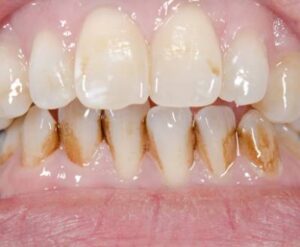What is it?
Tooth discoloration is a common dental concern characterized by changes in the color of the teeth, which can occur due to various factors affecting the enamel, dentin, or pulp tissues. Discoloration can manifest as stains, spots, or overall changes in tooth color, ranging from yellow or brown discoloration to gray, black, or blue hues. Understanding the causes and types of tooth discoloration can help guide appropriate management and treatment options.
Here are some key points about tooth discoloration:
- Extrinsic Discoloration: Extrinsic discoloration occurs when stains or pigments accumulate on the surface of the enamel, typically due to external factors such as dietary habits, oral hygiene practices, or environmental exposures. Common causes of extrinsic discoloration include:
- Food and beverages: Consumption of deeply pigmented foods and drinks such as coffee, tea, red wine, berries, or curry can lead to extrinsic staining of the teeth over time.
- Tobacco use: Smoking or chewing tobacco products can result in extrinsic staining and discoloration of the teeth, often manifesting as brown or yellowish stains on the enamel surface.
- Poor oral hygiene: Inadequate brushing, flossing, or professional dental cleanings can allow plaque and tartar buildup on the teeth, contributing to extrinsic discoloration and surface stains.
- Intrinsic Discoloration: Intrinsic discoloration occurs when changes in the internal structure or composition of the tooth tissues affect the overall color of the tooth from within. Common causes of intrinsic discoloration include:
- Developmental factors: Genetic anomalies, enamel defects, or excessive fluoride intake during tooth development can lead to intrinsic discoloration of the teeth.
- Aging: As individuals age, the enamel layer may wear down, exposing the underlying dentin, which is naturally yellowish or brown in color, resulting in intrinsic discoloration and a darker appearance of the teeth.
- Trauma or injury: Dental trauma, such as falls, accidents, or sports injuries, can disrupt blood flow to the developing teeth or cause internal hemorrhage, leading to intrinsic discoloration or tooth darkening over time.
- Medications: Certain medications or medical treatments, such as tetracycline antibiotics (when taken during tooth development), chemotherapy, or radiation therapy, can cause intrinsic discoloration of the teeth, particularly in children or adolescents.
- Combined Discoloration: In some cases, tooth discoloration may result from a combination of extrinsic and intrinsic factors, where surface stains accumulate on the enamel surface, while underlying structural changes contribute to internal discoloration.
- Diagnosis: Diagnosis of tooth discoloration involves a thorough clinical examination, assessment of medical and dental history, and identification of potential causative factors. Dental X-rays and other diagnostic tests may be performed to evaluate the internal structure of the teeth and rule out underlying pathology or anomalies contributing to discoloration.
- Treatment: Treatment of tooth discoloration depends on the underlying causes and severity of the discoloration. Management options may include:
- Professional dental cleanings to remove surface stains and plaque buildup.
- Teeth whitening treatments to lighten and brighten the enamel surface.
- Dental restorations such as veneers or crowns to cover or mask intrinsic discoloration.
- Prevention measures such as proper oral hygiene practices, dietary modifications, and lifestyle changes to minimize the risk of tooth discoloration.
In summary, tooth discoloration can result from a variety of factors affecting the enamel, dentin, or pulp tissues. Diagnosis and treatment of tooth discoloration require a comprehensive approach to address both surface stains and underlying structural changes, with management options ranging from professional dental cleanings and teeth whitening to dental restorations and preventive measures to maintain oral health and aesthetics.

